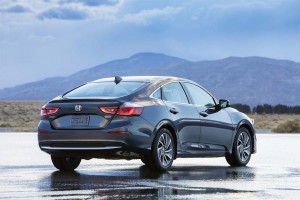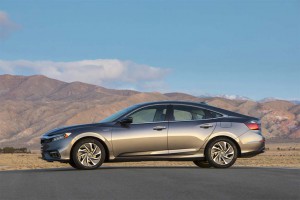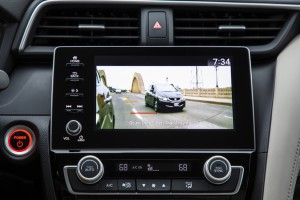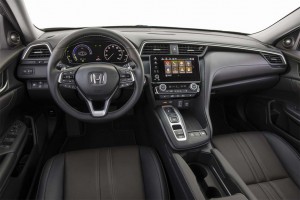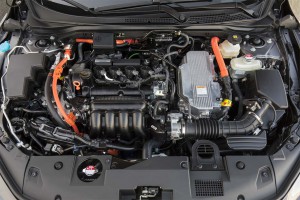It was quite literally another century when the first Honda Insight came to the U.S. market. Beating the now familiar Toyota Prius by several months, Honda’s originally hybrid was a quirky little two-seater that, in one configuration, delivered more than 70 miles per gallon.
But its trade-offs were many and, unlike its HEV rival, sales of the original Insight tanked, Honda soon pulling it from the market. But the Japanese automaker brought the nameplate back in 2008, this time as a five-door hatchback promoted as the lowest-priced hybrid available in the U.S. It didn’t fare any better and was culled from the line-up in 2014.
Now, Honda is back with a third-generation Insight and, if our initial drive is any indication, three’s a real charmer. While the 2019 Honda Insight delivers some of the best mileage numbers on the market, reaching as much as 55 miles per gallon on the highway, it is far more appealing in other ways, including its design and its fun-to-drive factor.
The timing of the launch is a mixed bag, however. On the plus side, fuel prices have been surging in recent months, and are currently topping $3 a gallon in many parts of the country, making mileage an issue consumers are considering again when making purchase decisions. That said, sales of utility vehicles continue to run at record numbers, in part because there are plenty of more fuel-efficient crossovers available today than ever before. The big question Honda officials have had to contend with is why didn’t they revive the Insight as a CUV?
The simple fact is that they didn’t. But, if any brand still knows how to sell sedans, it’s Honda, as its ever-strong Civic and Accord models demonstrate. In fact, a quick perusal of the new 2019 Insight reveals that it is based on the latest-generation Civic, here slightly stretched. The new hybrid rides on a 106.3-inch wheelbase, with an overall length of 183.6 inches, a width of 71.6 inches and a height of 55.5 inches.
Perhaps more importantly, by switching to a lithium-ion battery, Honda has been able to tuck the pack under the back seat, freeing up cabin and cargo space, the new Insight packing in 15.1 cubic feet of trunk capacity before using the split-fold rear seats.
The design of the new Hybrid is a bit more sophisticated than that of the Civic sedan, Insight aimed at a slightly more upscale and mature buyer than the stock Civic. That carries through in exterior features such as the standard LED head and taillights.
(Honda, Chevrolet take top spots on Best Family Car list. Click Here for the story.)
“More than anything, we wanted to make (Insight) look wide,” giving the car a planted and roomy appearance, explained Noriyuki Sato, the chief engineer on the project, during a briefing ahead of our drive in Minneapolis earlier this month.
Inside, the Insight also gets a more roomy and upscale feel with little details like its horizontally laid-out instrument panel. Of course, it features Honda’s familiar, touch-based infotainment system. The automaker has made some well-appreciated improvements. It’s a bit quicker than early versions and now features a real volume knob. (Would we be greedy in calling for a tuning knob, as well?)
That said, we’re among the school that wishes Honda would abandon its camera-based blind-spot monitoring system. Lane Watch is great, in concept, but it only covers the right side of the vehicle and, when you trigger it by switching on the right turn signal, everything else on the touchscreen vanishes, including any navigation instructions you might need as you prepare for your turn. Please, Honda, go with a more conventional blind-spot system.
Those, however, are among the few complaints we can levy against the new Insight. And we certainly appreciate the array of upscale features, including Honda’s latest safety suite with such niceties as forward collision warning with auto-braking. There’s active cruise control that can take you down to a complete stop in traffic, as well as lane centering, and in that infotainment system both Android Auto and Apple CarPlay functionality.
We certainly appreciate the third-generation hybrid’s drivetrain. It’s a variant of the two-motor HEV system found in the latest Honda Accord Hybrid, but with the gasoline portion of the system downsized to 1.5 liters and capable of making 107 horsepower. The drivetrain is rather complex but, under most circumstances, the Insight’s wheels are motivated by an electric motor making 129 hp and 197 pound-feet of torque, the internal combustion side primarily serving as a generator to supplement what’s in the battery. And that’s not much. Honda won’t reveal the exact size of the lithium pack but confirms it gets a maximum 1 mile in pure EV mode.
(Click Here for details about GM and Honda partnering on new battery technology.)
The numbers may not sound like much but there’s plenty of torque when you need it, whether off-the-line or making a pass. Switching to Sport Mode helps keep the revs up and enhance the sportiness of the drive experience.
Honda officials made a point of noting the paddle shifter on the left side of the steering wheel which, they claimed, was meant to increase regenerative braking. On some vehicles, especially all-electric and plug-in hybrids, regen can be significant enough to work like a brake and allow for one-pedal driving under many situations. Not so with the Insight, however. To be honest, we barely could feel the difference with the paddle depressed. It’s a topic Honda insiders say they will continue to study to see if more regen might be dialed in at a future point.
What’s impressive is that the new Insight also delivers some of the best fuel economy numbers you’ll find on the road today. The base version comes in at 55 mpg City, 49 Highway and 52 Combined. (Hybrids generally get their best numbers in urban, stop-and-go situations.) The Touring model drops that to a still-impressive 51/45/48.
With its variable ratio steering, MacPherson front suspension and multi-link rear, the new sedan also offers a comfortable yet well-planted driving experience. We actually found it a bit more enjoyable under hard driving than the standard Civic sedan.
As for pricing, the Insight is no longer the cheap-and-cheerful little econ-hybrid Honda tried to position it as in its second-gen form. But it’s still reasonably affordable, starting at $23,725 for the base LX and pushing up to $29,985 for a near fully loaded Insight Touring edition.
(To see more about Honda kicking off production of two new models, Click Here.)
Adding it all up, we’d have been confident in predicting the third-generation hybrid would finally be the hit Honda has long hoped for. But that’s past tense and based on a market still hungry for good sedans. In today’s world, well, it’s far less certain. Buyers seem ready to plunk down their cash for anything with a utility vehicle shape while ignoring some downright delightful four-door passenger cars. But, as we noted, Honda has proven itself capable to selling sedans in an SUV world, and it would be a shame if they couldn’t work their magic with the new Insight, as well.


